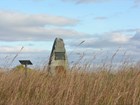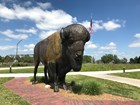Have you ever wondered what the experience was like for the emigrants who traveled west on the Great Platte River Road?
-
Article 1: Traveling the Emigrant Trails
Learn a little bit about what life was like for the emigrants traveling west by covered wagon. Read more
-
Article 2: Wagons on the Emigrant Trails

Emigrants along the western trails had several options when it came to wagons. Read more
-
Article 3: Death and Danger on the Emigrant Trails

There were many life-threatening challenges for the emigrants who traveled the emigrant trails to California, Oregon, or Utah. Read more
-
Article 4: Cholera: A Trail Epidemic
In the early years of the California gold rush, cholera struck each spring at the thronging jumping-off towns along the Missouri River where thousands of gold seekers and Oregon-bound emigrants gathered to outfit. The deadly disease claimed many lives before the victims even had a chance to start across the prairies of Kansas or Nebraska. It claimed many more along the trail corridor to Fort Laramie, Wyoming, and in American Indian encampments and villages, as well. Read more
-
Article 5: A Gathering Storm: American Indians and Emigrants in the 1830s
As American settlers surged westward across the eastern woodlands and prairies in the early 19th century, they pushed American Indians out of their ancestral homes. The U.S. government resettled many of those displaced Eastern tribes —the Kickapoo, Delaware, Potawatomi, and others— in congressionally designated Indian Territory west of the Missouri River and south of the Platte. The resettled Eastern tribes were among the first Indians encountered by emigrants through Kansas. Read more
-
Article 6: The Platte Experience
Otoe Indians called this region “Nebrathka,” meaning “flat water,” and the French word “Platte” means the same. The defining flatness of the broad Platte River Valley, which averages five to seven miles wide, made it ideal for animal-powered travel on both sides of the stream. The long Platte River also provided plenty of water and native grasses for game and livestock. Many emigrants later recalled it as the easiest, most pleasant part of their westering journey. Read more
-
Article 7: “Thicker than Stars in the Firmament”: Bison along the Platte River Corridor

Emigrants heading west along the Platte River in the early years of the overland emigration wrote excitedly in diaries and journals about their first sightings of buffalo and the wild hunts that typically followed. Some wagon trains got caught in buffalo stampedes, and some lost cattle that ran off to join the unimaginably enormous herds of wild bison. But as commercial hunters and sport-slaughter thinned those herds that part of the overland experience changed. Read more
-
Article 8: Women Traveling West

The Oregon and California trails traverse lands where women challenged traditional gender roles. In the early 1840s Americans began heading west in large numbers, many traveling in family groups. Women in the nation’s more settled areas were supposed to excel at domestic work, like cooking, cleaning, and raising children; however, as part of a wagon train, women got to showcase a wider range of skills. Read more
-
Article 9: War on the Oregon & California Trails

Once-friendly Western tribes watched with mounting anger as emigrants helped themselves, often wastefully, to their game, grass, water, and wood. Indian agents warned of bloody conflicts ahead if the issues between native peoples and emigrants were not soon resolved. In response, the U.S. government called for a treaty conference to be held near Fort Laramie, Wyoming, in September 1851. Some 12,000 members of 11 different Northern Plains tribes answered the call. Read more


